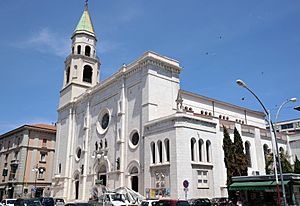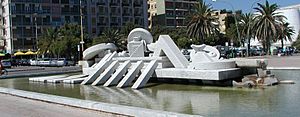Province of Pescara facts for kids
Quick facts for kids
Province of Pescara
Pescara
|
|
|---|---|
 |
|
| Country | |
| Region | Abruzzo |
| Capital | Pescara |
| Area | |
| • Total | 1,225 km2 (473 sq mi) |
| Population
(2007)
|
|
| • Total | 312,215 |
| • Density | 255/km2 (660/sq mi) |
| Postal Code |
65010-65014, 65016-65017, 65019-65020, 65022-65024, 65026-65029
|
| Telephone prefix |
085
|
| ISTAT | 068 |
| Vehicle registration | PE |
| No. of communes | 46 |
The Province of Pescara (which in Italian is provincia di Pescara) is a special area in the Abruzzo region of Italy. It's like a county, and its main city is Pescara. This city is also its capital.
As of 2017, about 319,936 people live in the Province of Pescara. It covers an area of about 1,230 square kilometers (or 475 square miles). The province has 46 smaller towns and villages, which are called comuni in Italy.
Contents
History of Pescara Province
People first started living in the Pescara area around 1500 BCE. We don't know exactly which ancient tribe settled there first.
The Romans took control of the area in 214 BCE. They called the city "Aternum." It became an important place for shipping and trade between the Balkans and Rome. The Romans even made it the capital of their Valeria region.
Later, during times of barbarian raids, the city was almost completely destroyed. It then slowly grew back as a fishing village called Piscaria.
In the 1500s, Charles V, Holy Roman Emperor turned Piscaria into a military fort and renamed it Pescara. This fort helped Pescara survive many attacks from Turkish Muslims.
For a short time in the 1700s, the Austrians ruled Pescara. After that, it came under the control of the House of Bourbon. They made it part of a larger area called Abruzzo Citra.
Pescara joined the Kingdom of Italy in 1860. It was still mostly a fortified city. In 1927, Pescara became the capital of the Abruzzo region. Sadly, during World War II, about 78% of the city was destroyed by bombs.
Geography of Pescara Province
The Province of Pescara is located in the middle of the four provinces in the Abruzzo region. It's on the eastern coast of Italy.
To the northeast, it touches the Adriatic Sea. The Province of Teramo is to its north. The Province of L'Aquila is to its west and south. To the south and east, you'll find the Province of Chieti.
The main city and capital, Pescara, is a port city. It sits right where the Aterno-Pescara River flows into the sea.
Main sights in Pescara
The city of Pescara is split into two parts by the river.
Historic South Shore
The older part of the city is on the south side of the river. This is where a fortified town, called the Piazzaforte, once stood. It was a military stronghold for the Kingdom of the Two Sicilies.
Here you can find the Bagno Borbonico. This was an old prison built starting in 1510 by order of Charles V, Holy Roman Emperor. It even included parts of ancient Norman and Byzantine city walls. Today, this building is home to the Museum of the Abruzzi people. This museum has 13 rooms that show 4,000 years of history about the people of Abruzzo. It teaches about their daily life, traditions, and how they made a living.
Also in the historic center are the birthplaces of famous people like Gabriele D'Annunzio and Ennio Flaiano. You can also see the beautiful San Cetteo Cathedral, which was built between 1933 and 1938.
Modern North Shore
On the north side of the river, you'll find Piazza Italia (Italy Square). The City Hall and the Government Building are located here. These buildings house the offices for the Province of Pescara. They were both built during the Fascist era in a style called fascist rationalist. The architect Vincenzo Pilotti designed them. He also designed many other public buildings in the city. These include the local Chamber of Commerce, the "G. D'Annunzio" high school (Liceo Classico), and the old courthouse (which is now a museum).
Other Interesting Places
In the very south of the city, near the D'Avalos Park and the beach, there's a lovely area with Art Nouveau villas. These elegant houses were designed in 1912 by Antonino Liberi. He was an engineer and the brother-in-law of Gabriele D'Annunzio.
You can also visit the Aurum building. It was first a social club, then a liquor factory. Today, it's a public space used for many different events.
In 2007, the Ponte del Mare was built. This is the largest bridge in Italy just for people walking and cycling!
On the northern waterfront, near Salotto Square (the city's main square), there is a sculpture called the Nave (which means "the ship"). It was created by the artist Pietro Cascella.
See also
 In Spanish: Provincia de Pescara para niños
In Spanish: Provincia de Pescara para niños




